By Joseph Essertier, World BEYOND War, March 9, 2022
Ever since the Russian government started its attack on Ukraine on the 24th of February, large numbers of people have gathered on streets in Russia, Europe, the U.S., Japan, and other regions of the world to show their solidarity with the people of Ukraine and demand that Russia withdraw its forces. Putin claims that the goal of the violence is to demilitarize and de-Nazi-fy Ukraine. He stated, “I made the decision to hold a special military operation. Its goal is to protect the people that are subjected to abuse, genocide from the Kiev regime for eight years, and to this end we will seek to demilitarize and denazify Ukraine and put to justice those that committed numerous bloody crimes against peaceful people, including Russian nationals.”
While some advocates of peace would agree, in general, that demilitarizing and de-Nazi-fying a country is a worthwhile goal, we completely disagree that more violence in Ukraine will help achieve such goals. We always reject the typical state propaganda whose stupidity was expressed as “War is peace. Freedom is slavery. Ignorance is strength” in George Orwell’s dystopian social science fiction novel Nineteen Eighty-Four (1949). Most long-term peace advocates know that Russians are being manipulated by their government; some of us are also aware that we in the richest countries are being manipulated by claims that Russia interfered in the 2016 U.S. elections and was largely responsible for Trump’s victory. Many of us do know the time of day. We remember the words “truth is the first casualty in war.” During the last five years or so, I have often proudly worn my World BEYOND War T-shirt with the words “The first casualty of war is truth. The rest are mostly civilians.” We have to stand up now for truth, and for the safety of civilians and soldiers.
Below is just a short report, a sampling and a subset, of the protests in Japan that I am aware of.
There were protests in Japan on the 26th and 27th of February in Tokyo, Nagoya, and other cities. And the weekend of the 5th and 6th of March saw relatively large protests all across Okinawa/Ryūkyū and Japan, although the protests have not yet reached the scale of the protests against the 2001 U.S. invasion of Afghanistan. Unlike what happens to Russians who protest their government’s violence, and unlike what happened to Canadians during their state of emergency, Japanese can still stand on the streets and voice their opinions without being arrested, beaten up, or having their bank accounts frozen. Unlike in Australia, war-time censorship has not become too extreme, and Japanese can still access websites that contradict U.S. government claims.
Nagoya Rallies
I participated in a protest on the evening of the 5th of this month, as well as in two protests during the day on the 6th, all in Nagoya. On the morning of the 6th in Sakae, a central area of Nagoya, there was a brief gathering from 11:00 AM to 11:30, during which we listened to speeches from prominent peace advocates.
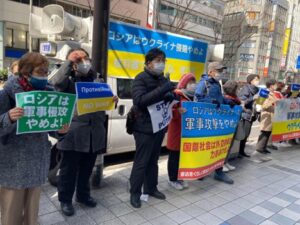
Then from 11:30 to 3:00 PM, also in Sakae, there was a much larger gathering organized by the Japanese Ukrainian Culture Association (JUCA). JUCA also organized a protest the previous weekend on the 26th, which I did not attend.
All the major newspapers (i.e., the Mainichi, the Asahi, the Chunichi, and the Yomiuri) as well as NHK, the national public broadcaster, covered the JUCA rally in Nagoya. Like the other rally in the morning of the 6th that I attended, the atmosphere among the participants at JUCA’s large rally on the 6th was warm and cooperative, with dozens of leaders from peace organizations also participating. The majority of the time for speeches was allotted to speeches by Ukrainians, but several Japanese spoke, too, and the JUCA organizers, in a free, generous, and open spirit, welcomed anyone to speak. Many of us took the opportunity share our thoughts. The JUCA organizers—mostly Ukrainians but also Japanese—shared their hopes, fears, and the stories and experiences from their loved ones; and informed us about their culture, recent history, etc. A few Japanese who had visited Ukraine before as tourists (and perhaps also on friendship tours?) told about the good experiences they had and about the many kind, helpful people they met while there. The rally was a valuable chance for many of us to learn about Ukraine, both pre-war Ukraine and the present situation there.
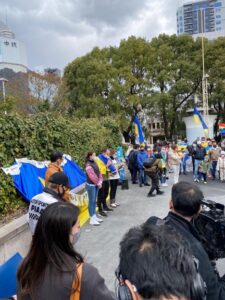
We marched for a little less than an hour and then returned to a central plaza called “Edion Hisaya Odori Hiroba.”
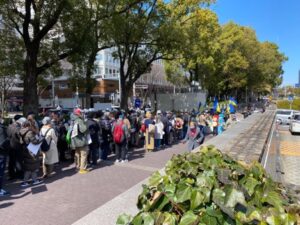
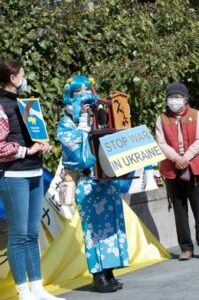
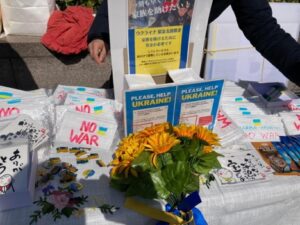
I did not hear, or at least notice, any warmongering speeches or demands for revenge against Russians at this rally at Edion Hisaya Odori Hiroba on the 6th. The meaning ascribed to the flags seems to have been “let’s help out Ukrainians during this crisis” and seemed to indicate solidarity with Ukrainians during a difficult time for them, and not necessarily support for Volodymyr Zelenskyy and his policies.
I had some good conversations outside in the fresh air, met a few interesting and warm-hearted people, and learned a little about Ukraine. Speakers shared their views about what was happening with the audience of a few hundred people, and appealed to people’s sympathy for Ukrainians and common sense about how to get out of this crisis.
On one side of my sign, I had the single word “ceasefire” (which is expressed in Japanese as two Chinese characters) in large type, and on the other side of my sign I put the following words:
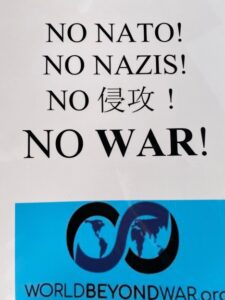
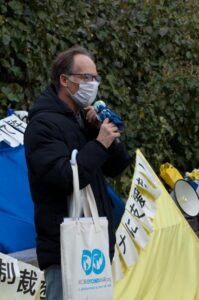
A Rally against War by a Labor Union
“When the rich wage war, it’s the poor who die.” (Jean-Paul Sartre?) Thinking of the impoverished wretched of the world, then, let’s start with a rally that made a similar statement, the one organized by the National Union of General Workers of Tokyo East (Zenkoku Ippan Tokyo Tobu Rodo Kumiai). They emphasized three points: 1) “Opposed to war! Russia and Putin must end their invasion of Ukraine!” 2) “The U.S.-NATO military alliance must not intervene!” 3) “We will not allow Japan to revise its Constitution and go nuclear!” They rallied in front of the Japan Railways Suidobashi Train Station in Tokyo on the 4th of March.
They warned that arguments such as “Article 9 of the Constitution cannot protect the country” are gaining currency in Japan. (Article 9 is the war-renouncing part of Japan’s “Peace Constitution). The ruling class with the ruling Liberal Democratic Party (LDP) has been pushing revision of the Constitution for decades. They want to turn Japan into a full-fledged military power. And now is their chance to make their dream reality.
This labor union says that workers in Russia, the U.S., and around the world are rising up in anti-war actions, and that we should all do likewise.
Rallies in the Southwest
On the morning of the 28th in Naha, the capital city of Okinawa Prefecture, a 94-year-old man held up a sign with the words “bridge of nations” (bankoku no shinryō) on it. This reminds me of the song “Bridge over Troubled Water” that was banned in the U.S. during a previous war but gained in popularity and was played by radio stations even more. This elderly man was part of a group called “Asato – Daido – Matsugawa Island-wide Association.” They appealed to commuters driving by, people who were on their way to work. During Japan’s last war, he was forced to dig trenches for the Japanese Imperial Army. He said that during the war, it was all he could do to keep himself alive. His experience taught him that “war itself is a mistake” (which expresses the same idea as the WBW T-shirt “I’m already against the next war”).
Apparently, due to concerns about the invasion of Ukraine and the emergency in Taiwan, additional military fortifications are being made in Ryūkyū. But the U.S. and Japanese governments face stiff resistance to such military build-up there because Ryūkyūans, people his age above all, have truly known the horrors of war.
On the 3rd of March, groups of high school students across Japan submitted a statement to the Russian Embassy in Tokyo protesting Russia’s invasion of Ukraine. They said, “The act of threatening others with nuclear weapons goes against the global movement to prevent nuclear war and avoid an arms race.” This action was called by the Okinawa High School Students Peace Seminar. One student said, “Young kids and children my age are crying because a war has started.” She said that Putin’s stance hinting at the use of nuclear weapons indicates that “he has not learned [the lessons of] history.”
On the 6th of March in Nago City, where the highly-contested Henoko Base construction project is underway, the “All Okinawa Conference Chatan: Defend Article 9” (All Okinawa Kaigi Chatan 9 jō wo Mamoru Kai) held an antiwar protest along Route 58 on the 5th of May. They said that “no problems will be solved by military force.” One man who experienced the Battle of Okinawa pointed out that military bases in Ukraine are being attacked, and that the same thing will happen in Ryūkyū if Japan completes construction of the new U.S. base in Henoko.
Going further north from Okinawa, on the 4th, a rally protesting Russia’s invasion of Ukraine was held in front of Takamatsu Station, Takamatsu City, Kagawa Prefecture, on the island of Shikoku. 30 people gathered there, holding placards and leaflets and chanting “No war! Stop the invasion!” They distributed leaflets to commuters at the train station. They are with the Antiwar Committee of 1,000 of Kagawa (Sensō wo sasenai Kagawa 1000 nin iinkai).
Rallies in the Northwest
Moving to the far north, to Japan’s largest northern city that is only 769 kilometers from Vladivostok, Russia, was the protest in Sapporo. More than 100 people gathered in front of JR Sapporo Station with signs that read “No War!” and “Peace for Ukraine!” Ukrainian Veronica Krakowa, who attended this rally, is from Zaporizhia, Europe’s largest nuclear power plant. To what extent this plant is safe and secure is no longer clear now, in what we call the “fog of war.” She says, “I have to contact my family and friends in Ukraine many times every day to see if they are safe.”
I also talked to a Ukrainian in Nagoya who said something similar, that he was calling his family constantly, checking on them. And with escalation of words and deeds on both sides, the situation could get much worse, very quickly.
Rallies demanding peace for Ukraine were held in numerous locations in Niigata, according to this article in Niigata Nippō. On the 6th of August in front of JR Niigata Station in Niigata City, approximately 220 people participated in a march demanding Russia’s immediate withdrawal from the region. This was organized by Article 9 Revision No! All Japan Citizens Action of Niigata (Kyūjō Kaiken No! Zenkoku Shimin Akushon). A 54-year-old member of the group said, “I was saddened to see Ukrainian children shed tears in the news reports. I want people to know that there are people all over the world who wish for peace.”
On the same day, four peace organizations in Akiha Ward, Niigata City (which is 16 kilometers south of Niigata Station) jointly held a protest, with about 120 people participating.
In addition, seven members of a group called Yaa-Luu Association (Yaaruu no Kai) who oppose U.S. military bases in Ryūkyū, held signs with words such as “No War” written in Russian in front of JR Niigata Station.
Rallies in Metropolitan Areas in the Center of Honshū
Kyoto and Kiev are sister cities, so naturally, there was a rally on the 6th in Kyoto. Like in Nagoya, the people, who were in front of Kyoto Tower, called out, “Peace for Ukraine, Opposed to War!” About 250 people, including Ukrainians living in Japan, participated in the rally. They verbally expressed their wishes for peace and an end to the fighting.
A young lady by the name of Katerina, who is a native of Kiev came to Japan in November to study abroad. She has a father and two friends in Ukraine, and says she is told that they hear the sound of bombs exploding every day. She said, “It would be great if [people in Japan] continue to support Ukraine. I hope they will help us stop the fighting.”
Another young lady, Kaminishi Mayuko, who is a support worker for school children in Otsu City and is the person who called for the rally, was shocked when she saw the news of the invasion of Ukraine at home. She felt that the “war cannot be stopped unless each of us raise our voices and start a movement around the world, including Japan.” Although she had never organized demonstrations or rallies before, her Facebook postings brought people to gather in front of Kyoto Tower. “Just by raising my voice a little, this many people came together,” she said. “I realized that there are many people who are concerned about this crisis.”
In Osaka on the 5th, 300 people, including Ukrainians living in the Kansai region, gathered in front of Osaka Station, and as in Kyoto and Nagoya, called out, “Peace for Ukraine, Opposed to War!” The Mainichi has video of their rally. A Ukrainian man living in Osaka City called for the rally on a social networking service, and many Ukrainians and Japanese living in the Kansai region gathered. The participants held up flags and banners and repeatedly called out “Stop the War!”
A Ukrainian resident of Kyoto who is originally from Kiev spoke at the rally. S/he said that the fierce fighting in the city where her relatives live has made her anxious. “The peaceful time we once had has been destroyed by military violence,” s/he said.
Another Ukrainian: “My family takes refuge in an underground warehouse every time the sirens go off, and they are very tired,” s/he said. “They all have many dreams and hopes. We don’t have time for a war like this.”
On the 5th in Tokyo, there was a rally in Shibuya with hundreds of protestors. A series of 25 photos of that protest are available here. As one can see from the placards and signs, not all the messages advocate non-violent resistance, e.g., “Close the sky,” or “Glory to Ukrainian Army.”
There was at least one other rally in Tokyo (in Shinjuku), with probably at least 100 spectators/participants that was themed “NO WAR 0305.” A video of some of the music at NO WAR 0305 is here.
According to Shimbun Akahata, the daily newspaper of the Japanese Communist Party, which covered the NO WAR 0305 event, “On the 5th, the second weekend since the Russian invasion of Ukraine began, efforts to protest the invasion and show solidarity with Ukraine continued throughout the country. In Tokyo, there were rallies with music and speeches, and parades attended by at least 1,000 Ukrainians, Japanese, and many other nationalities.” There must have been, therefore, other rallies.”
About the event, Akahata wrote that citizens from various walks of life, including prominent artists, scholars, and writers, took the stage appealed to the audience to “think and act together to end the war.”
Musician Miru SHINODA delivered a speech on behalf of the organizers. In his opening declaration, he said, “I hope that today’s rally will help us all to think of other possibilities besides opposing violence with violence.”
NAKAMURA Ryoko said, the co-chair of a group called KNOW NUKES TOKYO, said, “I am 21 years old and from Nagasaki. I have never felt more threatened by nuclear weapons. I will take action for a future without war and nuclear weapons.”
Conclusion
If we are in the most dangerous moment since the Cuban Missile Crisis, these voices of peace are more precious than ever. They are the building blocks of human rationality, sanity, and perhaps a new civilization that completely rejects or severely restricts state violence. From the many photos available at the above links, one can see that a huge number of young people throughout the Archipelago of Japan (that includes the Ryūkyū Islands) have suddenly become concerned about war and peace issues, as a result of the disaster unfolding in Ukraine. It is unfortunate but true that people are not aware of the sickness until symptoms appear.
The dominant view in Japan, as in the U.S., seems to be that Putin is completely responsible for the current conflict, that the governments of Ukraine and the U.S., as well as the NATO military alliance (i.e., gang of thugs) were just minding their own business when Putin just went berserk and attacked. While there have been many condemnations of Russia, there have been few critiques of the U.S. or NATO (such as the one by Milan Rai). Such is also true of the several joint statements that I have skimmed through, among the dozens that have been issued by various types of organizations in the Japanese language.
I offer this incomplete, rough report of some initial responses throughout the Archipelago for other activists and future historians. Every person of conscience has a job to do now. We must all stand up for peace as these many responsible people did last weekend so that we and future generations may yet have a chance at a decent future.
Many thanks to UCHIDA Takashi for providing much of the information and many of the photos that I used in this report. Mr. Uchida was one of the main contributors to the movement against the Nagoya Mayor’s Nanking Massacre denialism that we worked for, from roughly 2012 to 2017.








